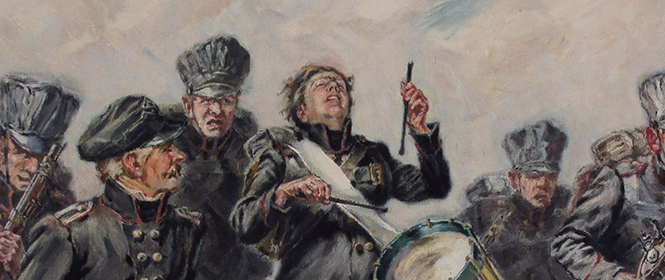
Change of Identity through Cross-dressing
A historical phenomenon
Thomas Jander | 2 February 2021
“Do we really need a true sex? With a tenacity bordering on rigidity, Western societies have claimed the affirmative.”[1] In the period of transition between the Late Middle Ages and the Modern Age this “rigidity” put women to death who decided to live their life as a man by wearing men’s clothing. In this article, Thomas Jander, head of the DHM Documents Collection, highlights a few of the historically recorded cases.
From around 1900 on, the sexologist Magnus Hirschfeld collected and published newspaper reports about people who attracted attention by appearing in public in clothing of the respective other gender. From these clippings he compiled a monograph that was published in 1910 under the title The Transvestites. There he not only “processed” this socio-sexological phenomenon systematically for the first time, but also coined the word “transvestism” or “transvestitism”, which remained the usual term to describe the practice for many years thereafter. Although there were numerous case studies, the monograph dealt only with a single woman. Hirschfeld later presented her with an expert medical opinion that made it possible for her to wear men’s clothes in public, which had often been grounds for arrests and indictments. During the time of the first German Republic, Hirschfeld and his colleagues at the Institute for Sexual Sciences wrote numerous similar opinions, whereupon the local police issued so-called transvestite certificates to those people. This allowed them to wear individual articles of clothing appropriate to their inclination, which in the early 20th century offered them at least a temporary avenue of escape from the criminalisation of cross-dressing that had been in effect since the Late Middle Ages.
Inequality. Order and society in the Late Middle Ages
Society in medieval Europe was ordered hierarchically in three principal estates. The clergy, the nobles, and the peasants together with the bourgeoisie each formed an estate that represented their rank and importance in the Christian world. The estates were understood as the God-given order of society. Women and men were born into their respective estate, which was thus also the main attribute of their identity. But as these class barriers began to become more porous in the Late Middle Ages, and various groups, such as professions or functions, formed their own “estates”, women still remained principally subordinate to men. Whereas men had many possibilities to shape their way of life, women, as a rule, were denied active participation in public life, so that they could only, figuratively speaking, find alternative styles of living in the narrow lane between house and nunnery.
To maintain the order of this generally accepted inequality, there were few codified legal texts in pre-modern times – except the Holy Scriptures. The Decalogue, the Ten Commandments, formed a kind of eternal law book, and Deuteronomy, the Fifth Book of Moses, contained individual laws, which in Chapter 22, Verse 5, treated the relationship between clothing and gender. In the first German-language Bible , the Mentelin Bible printed in Strasbourg in 1466, the verse was translated as follows: “Das weip werd nit gevast mit menlichem gewande: noch der man nuetz weiplich gewand. Wann der diez thut der ist verbrennlich bey dem herren,” [2] which in the King James version reads: “The woman shall not wear that which pertaineth unto a man, neither shall a man put on a woman’s garment: for all that do so are abomination unto the Lord thy God.”
In accordance with this religious, or rather church, rule, the secular social order, deemed God-given, had to become outwardly perceptible. Regarding clothing, the German cities therefore decreed regulations in the 13th century to visibly differentiate people according to estate, office, function, age – and sex. These rules gave expression to the social and gender hierarchies by assigning to the different categories specific articles, forms and accessories of clothing down to the smallest details. Class- and gender-specific clothing was thus a principal indication of social identity and therefore a kind of pre-modern identification card. The prohibition to wear clothing of the other sex was formulated in these ordinances, but seldom explicitly. The dress code of Speyer in 1356 stipulated that “no woman or maiden shall wear the coat of a man”.[3] Some of the urban “policy orders” of the Early Modern Age proscribed even at carnival time that “women shall not disguise themselves in men’s clothing and men not in women’s clothing because it can give occasion to the wanton vices of […] fornication and other crimes […].” [4]
Precisely in reference to “fornication”, the views of the Church and of secular authorities on criminal justice complemented each other. The condemnation of homosexual acts by the Church, for example, could also be found in (proto-)state legal texts. The Constitutio Carolina, the criminal law valid throughout the Holy Roman Empire since 1532, stipulated, for instance: “Likewise […] woman with woman, performing unchaste conduct / they shall forfeit their life / and according to the usual method be put from life to death by fire.” [5]
This opinion corresponded to the interest of both authorities to preserve the Christian marriage as the core of social order and to prohibit deviant, unfertile sexuality.
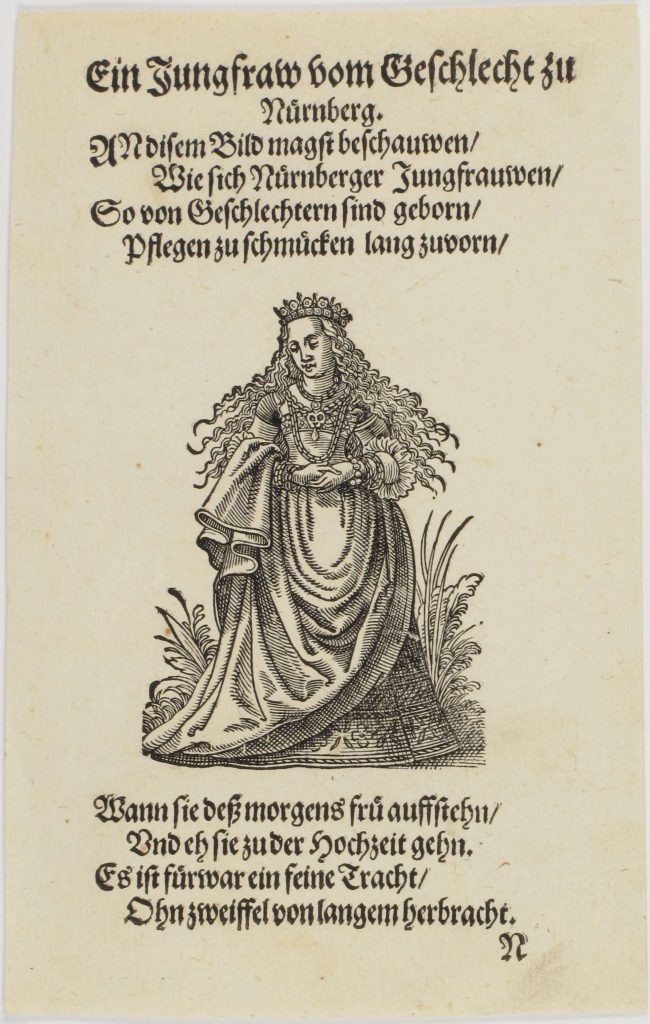
Ein Jungfraw vom Geschlecht zu Nuernberg, Grafik, Frankfurt a. M. 1586 © DHM
Death penalties. Female homosexuality and criminal law in the 15th and 16th centuries
Some of the historical examples of women overstepping the gender boundaries by wearing men’s clothes provide us with patterns of this forbidden practice as well as reactions to it by the authorities. In the Foucaultian sense, these actors are “infamous” people, because we would know nothing about their fate if the forces of power had not punished them for their way of life. The authorities’ perception of the phenomenon arose from a medieval mindscape in which a mixture of contradictory factors gave birth to something “monstrous” that violates the divine, natural and societal laws. Alongside the monsters of myth and folklore, we find this human mixture of the sexes: anyone who is both man and woman is a social monstrosity and thus endangers the order of society.
An early historical example of such a mixture of the sexes is the case of a woman from Nuremberg, Katherina Hetzeldorfer. She came to Speyer in 1475. For two years she lived there, dressed as a man, with her female companion, some of the time as siblings and at other times as a married couple. Hetzeldorfer was suspected of being a woman, denounced, and finally in 1477 brought before the Speyer municipal court. There, charges were brought against her, and after evidence was heard from a number of men and women, she was sentenced to death. The trial revealed that she not only consorted with her companion, but had sexual intercourse with other women in her male role. The main piece of evidence in the affair was a self-made dildo, which was described in detail by the court clerk as “an instrument […] made of red leather and filled with cotton in the front and pulled over a wooden stock”. In the end she was considered guilty of sodomy and “was put to death by drowning […] on the Friday before Sancti Widonis [Saint Guido of Pomponas Day, 2 May 1477]”.[6]
For the year 1537 the Basler chronicler Frydolin Ryff reported on “a woman wearing men’s clothing who was thus sentenced to death” after she had lived for many years as a man and had “served in the countryside as a farm hand and worked at threshing and other farm duties”. She also lived in marriage with a woman until “she began to beat her severely and to feast like any other dissolute fellow”. After she was arrested and put in prison, “she was tortured and racked”, and the court clerks recorded “that she was a woman”. She, too, was sentenced and “put to death by drowning on the reported day [24 September 1537]”.[7]
Another example has come down to us through the scribe Nikolaus Pol from Breslau, who noted in his chronicle, published in 1612, that on 23 August 1544, “a woman was sentenced to burn at the stake. For she wore men’s clothing, pretended to be a man, and called herself Hans Lose; [she] took two women as her wife, one of whom lost her health and her life through unnatural intercourse, while the other disclosed [the woman’s] knavery.” [8]
A fourth case is recorded in French court documents. In 1599 two women in Rouen were charged with sodomy and the woman who was living as a man was sentenced to death. Following appeals against the sentence, the condemned woman was examined a number of times by doctors. One of the experts finally came to the conclusion that the woman’s inner sexual organs were male and that she should therefore be considered a hermaphrodite. In the end, the court could not come to a uniform decision and acquitted the woman.
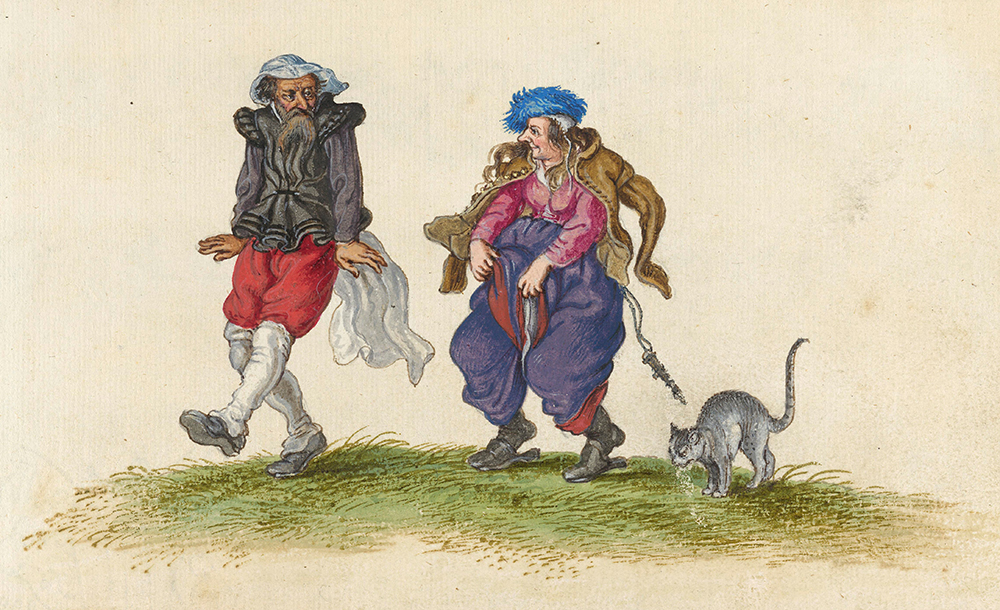
Paar mit Katze, der Mann trägt eine Frauenhaube mit Schleier sowie eine Frauenjacke, die Frau trägt eine Männermütze und Männerjacke, die Katze übergibt sich, Zeichnung, Adriaen Pietersz von de Venne, London, um 1620 © bpk / The Trustees of the British Museum
This acquittal represents a caesura because of the use of the examination method and its results: it was not, as usual, the exterior appearance of the body that counted, but the examination of the inner organs, which revealed the “truth” about gender and identity. This therefore stands for an initial shift in the perception of realities. With scientific methodology in the 17th and 18th centuries, new knowledge of the human body and of sexuality slowly began to be gathered, which – even more slowly – led bit by bit to a medical-biological pathologisation of laws governing sexual offences.
Refuges. Women as (male) soldiers in the 18th and 19th centuries
In the 18th century a case of female cross-dressing attracted considerable public attention in Prussia. On 8 November 1721, Catherina Margaretha Linck, who was living in Halberstadt as a man, was first beheaded and her body was then burned. Linck had been born in Glauchau in 1687 and grew up in the orphanage of the Francke Foundations there. From the age of 15 she lived as a man and fought in the War of the Spanish Succession under the name Anastasius Beurlein. In July 1708, before the Battle of Oudenarde, she deserted from the Electoral Brunswick-Lüneburg Infantry Regiment No. 6, was caught and sentenced to death for desertion according to martial law. Shortly before ascending the scaffold, Linck revealed her female identity. The execution was temporarily stayed and through the personal intervention of her educator, August Hermann Francke, completely suspended. Now again living in freedom in Halberstadt as a man under the name Anastasius Lagrantinus Rosenstengel, she married a woman, but poverty caused the couple to move to other locations several times and even to change their religion. In the end Linck/Rosenstengel was again detected and indicted. After an eventful trial, she was sentenced to life imprisonment, but Prussian King Friedrich Wilhelm changed the sentence to the death penalty.
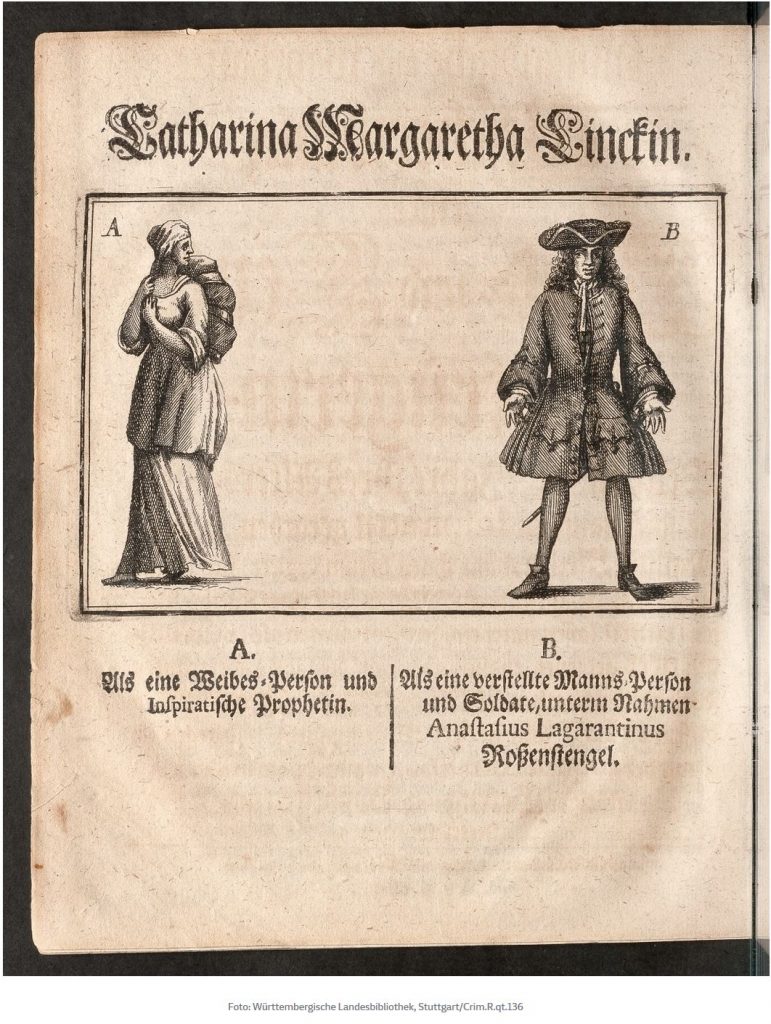
Porträt Catharina Margaretha Linck, Grafik, 1720 © Württembergische Landesbibliothek
This shows that in the prevailing concept of law in the 18th century, female “sodomy” was no longer unquestionably seen as deserving of death. It also became clear that the military had become a seemingly safe, temporary refuge and living space for “disguised” women. For in Europe, this phenomenon was still unusual, but not entirely anormal. Alone in the Netherlands, 120 women were identified between 1550 and 1839 as living entirely or temporarily as a man. Their biographies, dug up for the most part from court files, show that many women, often owing to poverty, led very mobile lives, in which they disproportionately often disguised themselves in men’s clothing and sought to serve in armies and fleets, whose open recruiting policies provided many of them with an outlet through which to escape from their primary identity. The Englishwoman Hannah Snell is just one example of other similar cases: in 1745 she became a soldier and after five adventurous years revealed her “true” sex. After quitting the army she demanded and received a pension for her service. She also published her story and for a short time became a kind of “media star”.
Some years later Prussia also got its legend of a female soldier: Eleonore Prochaska from Potsdam served for half a year in Lützow’s Free Corps in the so-called Wars of Independence under the name August Renz until she was wounded in the Battle of the Göhrde and her identity was revealed. She succumbed to her injuries on 5 October 1813. She was glorified as the “heroic maiden”, and her story was exploited in newspapers, poems and songs. Prochaska became the German “Joan of Arc”. She was in fact the most famous, but by no means the only, woman who served as a man in uniform against the French between 1813 and 1815. In the context of the anti-French conflicts, this role change was accepted as a patriotic deed of individual women and even honoured under certain circumstances. Public defamation would have unduly contradicted the construct of a “people’s war”, since these women came almost without exception from humble origins. At the same time, this crossing of boundaries remained an absolute exception in the contemporary discourse. At first ignored after the war, stories with exotic and anecdotal descriptions of the women began to spread in the second half of the century in the contemporary historical and dramatic literature.
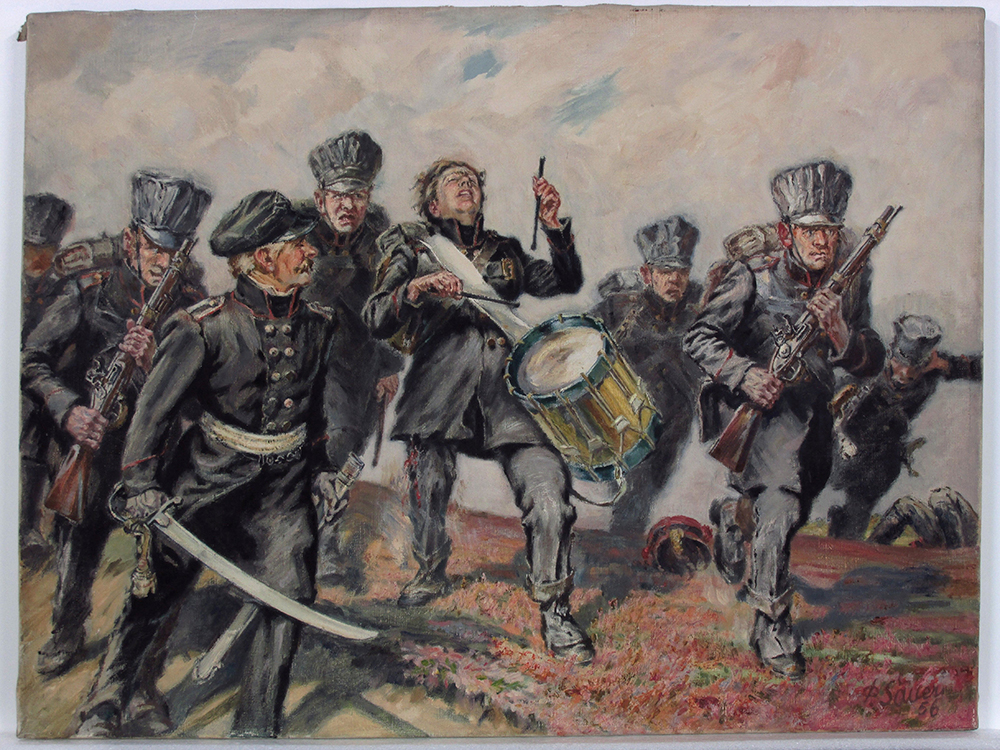
Eleonore Prochaska im Kampf, Paul Sauer, 1956 © DHM
Alternative Lifestyles. On the historical understanding of cross-dressing
Female cross-dressing was a European phenomenon that first began to appear in the 15th/16th centuries and was recorded primarily in court documents over the past 500 years, but which largely disappeared in the 19th century. The records always show similar and almost uniformly sinister stories of women who for a time or permanently lived as men, often with other women in a quasi-marital relationship, or in an actual marriage, until they were discovered, indicted and executed. But change was on the horizon. In the 15th and 16th centuries the courts usually sentenced the women to death and carried out the sentence, because this way of life was considered a threat to the divine order, the social hierarchy, and above all to the institution of marriage and its function of reproducing the population. In the 17th century, as a result of secularisation and enlightenment, a new, science-based understanding of the human body and sex arose, which meant a gradual easing of the practice of punishment. In addition, the historical examples show that the standing armies of the Early Modern Age on up to the 19th century often offered a temporary escape route from this way of living. Research findings often point out the fact that we only know about the attempts that failed and that the actual number of unreported cases of alternative biographies is much higher.
It does not really add anything to our knowledge to try to determine whether these women were in the current sense hetero-, homo-, inter- or transsexual or -gender/-ident. The terms or concepts of self that we use today cannot simply be transferred to historical groups or ways of living; moreover, the sources are often too one-sided and vague to provide enough evidence. But what we can determine is that since the Middle Ages, women have been creating variable leeways and living spaces for themselves through the practice of cross-dressing and identity exchange. This shows us that for centuries there have been remarkably creative and daring reactions to established gender boundaries and roles. From this perspective, these boundaries appear easier to overcome and not without alternatives.
Sources
[1] Michel Foucault, Das wahre Geschlecht, in: Ders., Über Hermaphrodismus. Der Fall Barbin, Frankfurt/Main, pp. 7 – 18, here p. 7.
[2] https://daten.digitale-sammlungen.de/0003/bsb00036981/images/index.html?id=00036981&groesser=&fip=193.174.98.30&no=&seite=6; (accessed on 4 July 2020).
[3] “[…] deheine vrouwe oder jungrouwe deheinen mannes mantel dragen”, cited from: Franz J. Mohne, Sittenpolizei zu Speier, Straßburg und Konstanz im 14. Und 15. Jahrhundert, in: Zeitschrift für die Geschichte des Oberrheins (7/1865), pp. 55-66, here p. 59.
[4] “[…] das Vermummen/ […] do sich Frauen in Manns und Mann in Frauen Kleidern [weil es zu] straefflichen Untugenden der […] Unzucht/ und andern Verbrechen Anlaß gegebe […]”. Erneuert und vermehrte Policey-Ordnung / des durchleuchtigsten Fürsten und Herrn/ Hern Christian Ernsten/ Marggrafens zu Brandenburg [etc.], Bayreuth 1672, XXIV, p. 62. (https://reader.digitale-sammlungen.de/de/fs1/object/display/bsb10490409_00001.html; accessed on 4 July 2020)
[5] “Item […] Weib mit Weib, unkeuschheit treiben / die haben auch das leben verwirckt / und man sol sie der gemeinen gewoheyt nach mit dem Fewer vom Leben zum Tod richten.” Deß aller Durchleuchtigsten Großmechtigsten, unüberwindlichsten Keyser Karls deß fünfften und deß Heyligen Römischen Reichs peinlich Gerichts Ordnung [etc.], Mainz 1543, Artikel 116. (https://reader.digitale-sammlungen.de/de/fs1/object/display/bsb10145168_00001.html; accessed on 4 July 2020)
[6] Cited from Helmut Puff: Weibliche Sodomie. Der Prozeß gegen Katherina Hetzeldorfer und die Rhetorik des Unaussprechlichen an der Wende vom Mittelalter zur frühen Neuzeit, in: Historische Anthropologie (Bd. 7 / Heft 3, 1993), pp. 364 – 380.
[7] https://reader.digitale-sammlungen.de/de/fs1/object/display/bsb11247533_00180.html (accessed on 20 January 2021), See also: Heide Wunder, Geschlechtsidentitäten. Frauen und Männer im späten Mittelalter und am Beginn der Neuzeit, in: K. Hausen, H. Wunder (Hg.), Frauengeschichte, Geschlechtergeschichte, Frankfurt 1992, pp. 131 – 136, here 133 f.
[8] Nicolaus Pol, Hemerlogion Silesiacum Vratislaviense, Breslau 1612, p. 318. (https://reader.digitale-sammlungen.de/de/fs1/object/display/bsb10012477_00354.html; accessed on 20 January 2021
Selected secondary literature on the topic
Rudolf Dekker, Lotte van de Pol, Frauen in Männerkleidern. Weibliche Transvestiten und ihre Geschichten, Berlin 1990.
Michel Foucault, Die Anormalen. Vorlesungen am College de France (1974 – 1975), Frankfurt / Main 2003.
Ute Gerhard (Hrsg.), Frauen in der Geschichte des Rechts: Von der Frühen Neuzeit bis zur Gegenwart, München 1997.
Magnus Hirschfeld, Die Transvestiten. Eine Untersuchung über den erotischen Verkleidungstrieb, Berlin 1910.
Klaus Latzel, Franka Maubach, Silke Satjukow (Hrsg.), Soldatinnen. Gewalt und Geschlecht im Krieg vom Mittelalter bis heute, Paderborn 2011.
Maximilian Schwochow, Die Ordnung der Hermaphroditengeschlechter. Eine Genealogie des Geschlechtsbegriffs, Berlin 2009.
Angela Steidele, In Männerkleidern. Das verwegene Leben der Catherina Linck alias Anastasius Langrantinus Rosenstengel, hingerichtet 1721, Köln u.a. 2004.